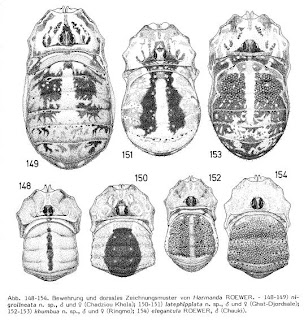
I've written before about the horrors attending on the Gagrellinae, a subfamily of mostly tropical harvestmen found in Asia and the Americas. But it's not all doom and gloom - outside the black hole that is the Gagrella concept, there's some sections that are quite pleasant.
Harmanda is one of the safer gagrelline genera, because unlike most gagrellines it's actually been revised, by Jochen Martens in 1987. Martens listed eleven species (one with four subspecies) from the Himalayas in the genus united by their distinctive male genital morphology - very flat, relatively broad shaft, with the mantle "wings" starting very shortly after the glans, and a long muscle extending at least half the length of the glans. Harmanda species also possess a short, round apophysis (side-branch) on the pedipalp patella (look at the pictures if you want to know what I mean - offhand, the pictures I'm using today are taken from Martens, 1987, because online images of Harmanda seem to be non-existent). Martens didn't mention two species earlier included in the genus by Roewer (1955) - Harmanda annulata from northern India and H. triseriata from Singapore. Like other gagrelline genera, Roewer assigned species to Harmanda based on little more than the number of nodules in each leg, a character that may not even be constant within one individual, let alone one genus, and the isolated geographic location of the Singapore species at least suggests that it may not be Harmanda. Roewer (1954)also divided Asian Gagrellinae into two "groups", Gagrelleae and Zalepteae, based on the presence (Gagrelleae) or absence (Zalepteae) of large central spines on the abdomen, and Harmanda would be zaleptean by this measure. But again, this feature was probably over-rated by Roewer - Martens (1987) described one genus, Pokhara, whose members were clearly related on the basis of genital morphology, but which included both "gagrellean" and "zaleptean" species.

Martens (1987) commented that Harmanda included some of the most eye-catching Himalayan Gagrellinae, with brightly metallic-coloured abdomens (metallic colours are unusual among arachnids, but a number of Gagrellinae go in for them). Most are inhabitants of oak and conifer forests, and can reach reasonable altitudes - Harmanda medioimmicans gets up to 3600 m.
Finally, I'll point out that northern India and the Himalayas may be a significant centre of diversity for Gagrellinae - a decent proportion of the species in this subfamily have been described from there. But the obvious question is, is this area truly particularly speciose, or have the harvestmen there been better studied than elsewhere?
REFERENCES
Martens, J. 1987. Opiliones aus dem Nepal-Himalaya VI. Gagrellinae (Arachnida: Phalangiidae). Courier Forschungsinstitut Senckenberg 93: 87-202.
Roewer, C. F. 1954. Indoaustralische Gagrellinae (Opiliones, Arachnidae). (Weitere Weberknechte XVIII). 1. Teil. Senckenbergiana Biologica 35 (3-4): 181-236.
Roewer, C. F. 1955. Indoaustralische Gagrellinae (Opiliones, Arachnidae). (Weitere Weberknechte XVIII). 4. Teil (Schluß). Senckenbergiana Biologica 36 (3-4): 123-171.
















No comments:
Post a Comment
Markup Key:
- <b>bold</b> = bold
- <i>italic</i> = italic
- <a href="http://www.fieldofscience.com/">FoS</a> = FoS